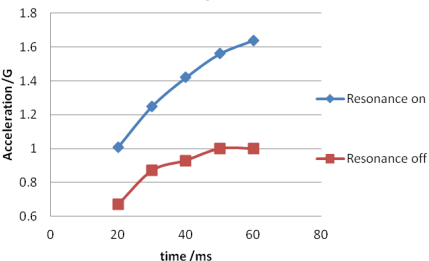SLOA194A May 2014 – January 2022 DRV2603 , DRV2604 , DRV2604L , DRV2605 , DRV2605L , DRV2605L-Q1 , DRV2624 , DRV2625 , DRV2667
- Trademarks
- 1Introduction
- 2How to Measure Energy
- 3Energy Consumption Comparisons for ERM, LRA and Piezo
- 4Energy Consumption Advantage of DRV260x and DRV262x Drivers
- 5Appendix A Energy Consumption of Actuators
- 6Appendix B. Test Setup Picture
- 7Appendix C. Energy Consumption Calculation for Smartphone Scenarios
- 8Revision History
4 Energy Consumption Advantage of DRV260x and DRV262x Drivers
The DRV260x and DRV262x drivers are a series of haptic drivers for ERM and LRA actuators. They contain many features that help reduce energy consumption for LRA actuators. One important feature is the auto-resonance tracking engine. Auto-resonance tracks the resonant frequency of an LRA in real time. If the resonant frequency shifts in the middle of a waveform for any reason, the engine will track the frequency cycle to cycle to maximize the actuator acceleration. By vibrating at the resonance frequency, the driver needs less energy per “g” of acceleration, which means instant energy savings.
 Figure 4-1 Buzz Waveform With Auto Resonant on/off
Figure 4-1 Buzz Waveform With Auto Resonant on/off| Acceleration (g) | Start Time (ms) | Stop Time (ms) | f (Hz) | Energy (mA/g) | |
|---|---|---|---|---|---|
| Resonance on | 1.64 | 56.0 | 14.5 | 175 | 28.4 |
| Resonance off | 1.00 | 51.7 | 71.6 | 185 | 51.8 |
Table 4-1 shows that acceleration is much larger and power consumption is much lower when auto-resonance is on. With auto-resonance on, the DRV2605 adapts to the changing LRA resonant frequency which is centered around 175 Hz. However, the driver no longer tracks the frequency when auto-resonance is off. That is why stronger acceleration is achieved when auto-resonance is on. The same holds true for all DRV260x and DRV262x devices.
Auto-resonance also improves the startup speed and stop speed of the actuators.
 Figure 4-2 Startup Speed
Figure 4-2 Startup Speed Figure 4-3 Stop Speed
Figure 4-3 Stop SpeedTable 4-1 shows that the start time with auto-resonance on is longer; however, this is a result of the higher acceleration due to auto-resonance. The auto-resonance engine can help actuators start and stop more quickly and reach the same acceleration in less time, just as Figure 4-2 and Figure 4-3 show. In Table 4-1 when auto-resonance is on, the actuator just needs slightly more time to produce a larger acceleration force.